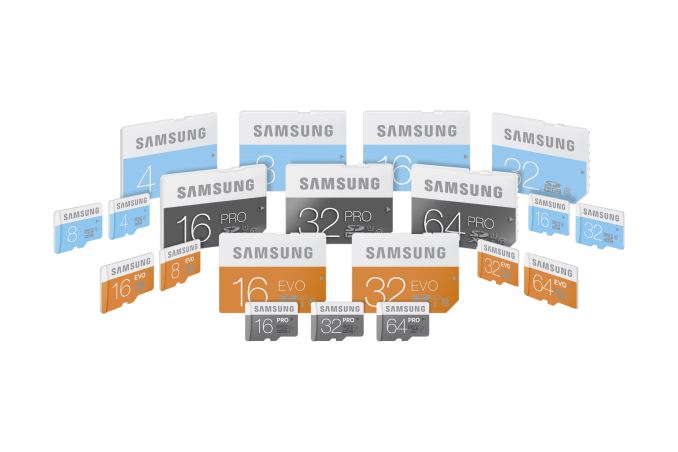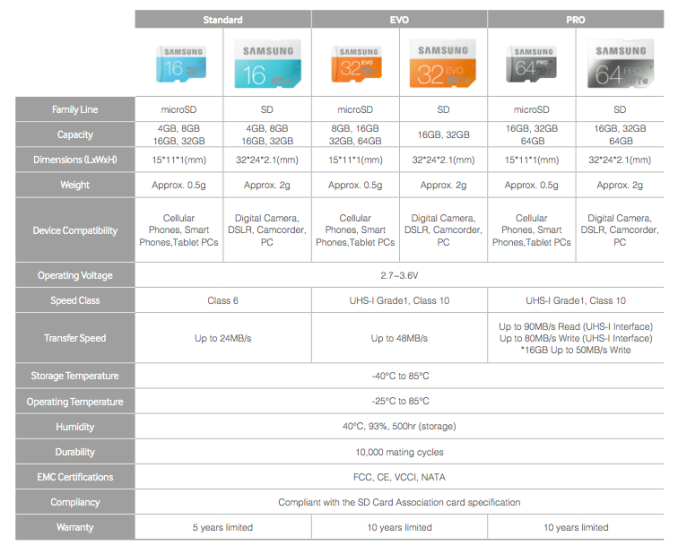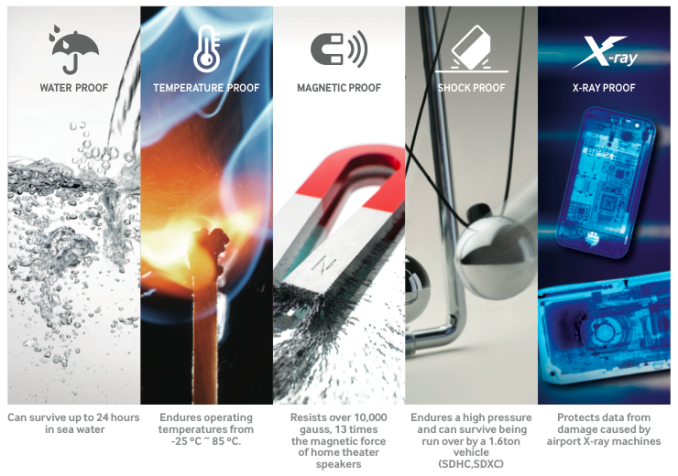Samsung Releases Standard, EVO and PRO SD Cards
by Kristian Vättö on April 7, 2014 10:05 AM EST
With the rapid decrease of NAND prices in the last few years, the SD card market has more or less become a commodity with very little differentiation. We don't typically note minor product releases but we'll make an exception here given that this one is a bit more significant than the average.
Samsung is revamping their whole SD card lineup at once by simplifying it into three product series: Standard, EVO and the PRO. Those who are familiar with Samsung's SSDs notice that the EVO and PRO brands are adopted from the 840 SSD series, which makes sense given Samsung's success in the SSD space and the brand they've been able to build with the 840 EVO and Pro.
Samsung's goal with the branding is to make it as easy as possible for the customer to select an SD card that fits their needs because oftentimes SD cards are marketed using the class system (like class 10), which may not tell much to an average SD card shopper. Electronics stores tend to have isles of SD cards available and differentiating in that space is extremely hard, so Samsung hopes that its simple branding will help to boost sales. Each brand also has a unique color (turquoise for Standard, orange for EVO and black for PRO) that aims to simplify branding even further and to allure customers (we all like vibrant colors, don't we?).

At the low level these are all MLC NAND designs but with varying quality of NAND being used. In fact only a small portion of the NAND meets the requirements for SSDs, the rest of the NAND is used in products where endurance and performance aren't as critical (such as USB drives, SD cards, eMMC...).
Update: As some of you speculated in the comments, the Standard and EVO models do in fact use TLC NAND, while MLC NAND is only used in the PRO model. The info we got from Samsung during the initial briefing was incorrect and we apologize for the confusion.
All in all, the SD card market as a whole is quite uninteresting. When you can get a decent SD card for a tenner or two, it's logical that not much time is spent on the purchase decision or research. Simple branding can help with that and the high-end niche for the PRO model does exist, but I still believe that the average buyer will just get the cheapest card available or the one that is recommended by the sales rep.











46 Comments
View All Comments
SDR104 - Thursday, November 27, 2014 - link
" random IO more than sequential, but no manufacturer rates their SD cards for random performance, it seems."Class 6 favors random over sequential
kadajawi - Tuesday, July 28, 2015 - link
I have made the experience that microSD cards are just as cheap, often times cheaper than SD cards. They are also more reliable/longer lasting. In most cases microSD cards perform really well. They are really fast. Maybe on the highest end there are faster, bigger SD cards, but I doubt many buy those. I'd rather have 2 or 3 microSD slots than one SD slot.scook9 - Monday, April 7, 2014 - link
In the X-Ray picture above they clearly show an iPhone which is a) an Apple product in a Samsung marketing picture and b) infamous for not having expandable storage such as an SD card slotnerd1 - Monday, April 7, 2014 - link
I bet the non-pro cards are TLC (as their last-gen cards). Some application like constant video recording still requires MLC I think.MrMaestro - Monday, April 7, 2014 - link
The speed ratings Samsung have provided are, unsurprisingly, optimistic. I bought a 32GB PRO MicroSD yesterday and write speed while connected to my PC through a hub was about 15MB/sec. Not terrible by any means but nowhere near the 80MB/sec quoted in the slide above.Thing is, I think Samsung aren't telling the whole truth with this PR, because the package I bought gives a write speed as a much more realistic 20MB/sec. Maybe the SD are different to the Micros, and if that's the case then it should be made clear in the slide.
hojnikb - Tuesday, April 8, 2014 - link
I bet you're limited by the card reader or usb hub (usb2 ?) and not the card itself.diud - Monday, April 14, 2014 - link
Sounds like a reader issue. The higher speeds make use of newer communication protocols.ET - Tuesday, April 8, 2014 - link
Previously Samsung had a 70MB/s read 20MB/s write card at a good price point, and that IMO was a good compromise. Now the 90MB/s will probably be quite expensive, while the 48MB/s will be significantly slower than 70MB/s.Anders CT - Tuesday, April 8, 2014 - link
The SD-card needs to die. The standard mandates a horrible, unreliable, insecure and slow file-format while not specifying any kind of wear-levelling or reliabillity expectations.Extensible flash-storage is highly useful and much needed, but the prevalence of a shoddy standard makes stands in the way of full industry support.
SDR104 - Thursday, November 27, 2014 - link
Lightning-UFD? :) death to SD